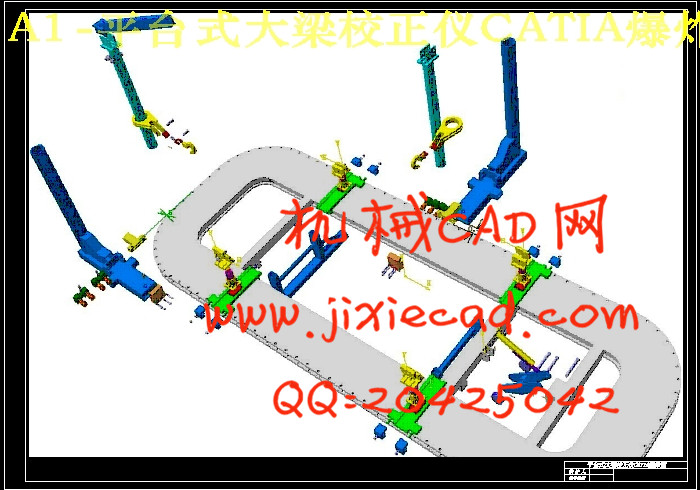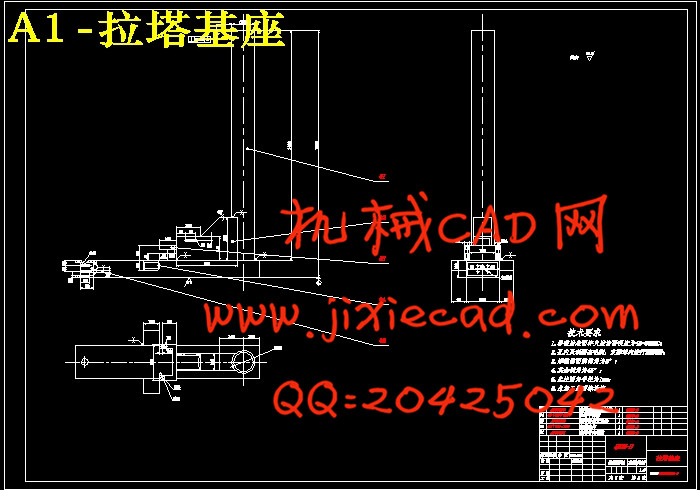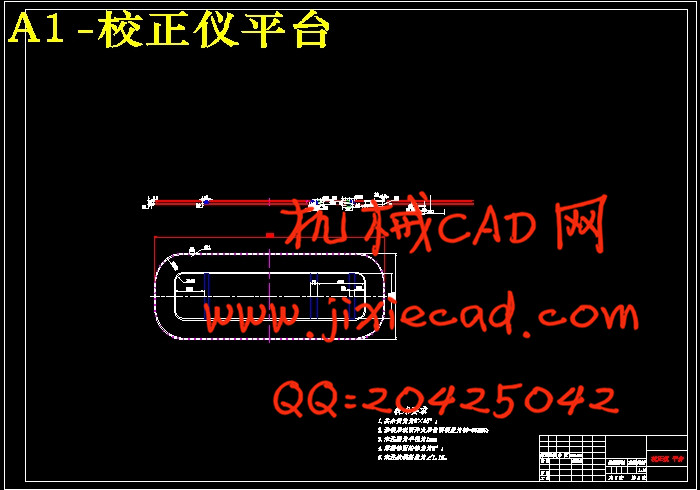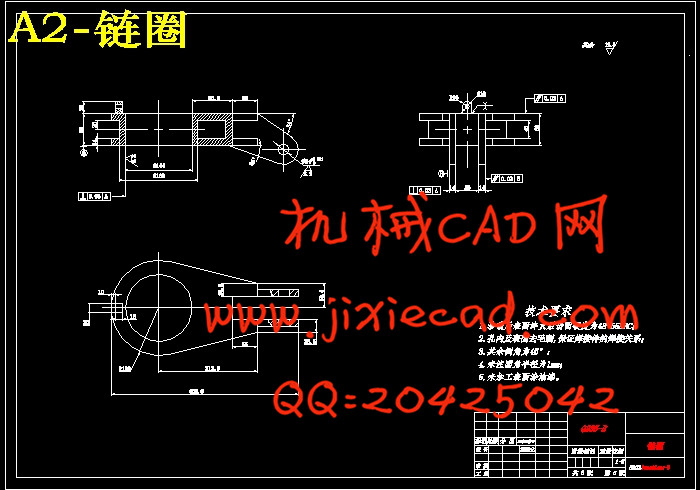设计简介
摘 要
车身校正是通过一定的外力将因事故损坏或疲劳损坏的部位修复到车辆出场时技术标准"状态“的过程。汽车在人们的日常生活中起着不可或缺的作用,当然有使用就会有损坏,而且损坏的情况也越来越严重,从而一些专门的修复工具也随之产生—平台式汽车车身校正设备。目前,国内普遍采用的车身校正设备主要有框架式和平台式,其中平台式较多。这种设备较为先进,国内外制造的设备一般都采用这种形式,是国际间比较流行的一种车身校正设备。平台式车身校正设备主要包括有举升支架,工作台,加力塔及其连接机构。本设计的目的旨在对平台式汽车大梁校正仪的二维设计及三维虚拟设计进行探索和实践,为校正仪的设计提供参考。
本设计是通过对现有设备的调查研究,再结合自己的想法设计一台结构简单,使用方便的平台式汽车大梁校正设备。本设计首先利用AutoCAD进行二维设计计算及校核,再利用三维建模软件CATIA对汽车大梁校正仪的整机进行虚拟建模,最后利用有限元受力分析软件ANSYS,对关键部件进行有限元分析。虚拟设计中首先利用三维建模软件CATIA对大梁校正仪整体三维实体进行建模,然后将关键部位零件文件类型另存为IGS格式,通过IGS格式将零件模型导入ANSYS进行有限元结构静力学分析,验证结果的可行性。利用CATIA和ANSYS软件对平台式汽车大梁校正设备的设计开发完全是在虚拟的环境中进行的,通过更改技术参数就可以实现对设计方案的完善,缩短开发周期,提高设计质量和效率,降低研发成本。这也是未来产品设计开发方法的发展方向。
关键字:大梁校正仪;结构设计;三维建模;虚拟装配;有限元分析
ABSTRACT
Body through certain correction is a force for accident damaged or fatigue damage repair to vehicles out of the technical standards “state” process.Car in People's Daily life plays an indispensable role, of course, have use will have damaged, and the damage situation of also more and more serious, which some special repair tools generates - using automotive calibration equipment.At present, the domestic car calibration equipment widely used are mainly frame type, including using more peaceful desktop.This equipment, advanced manufacturing equipment both at home and abroad are usually use this form, is international popular a kind of body calibration equipment.Using body calibration equipment mainly include lifting stents, workbench, strength tower and its connection institutions.
This design is based on the investigation and study of existing equipment, coupled with his own idea design a simple structure, easy to use and using car girders of calibration devices.Using three-dimensional modeling software CATIA, finite element stress analysis software ANSYS, the whole car girders is corrective on virtual modeling,the key components in finite element analysis.Firstly, the 3d modeling software to beam is corrective CATIA overall three-dimensional entity is modeled,then will key parts parts file types save as IGS format,through the IGS formats will import ANSYS finite element part modeling statics analysis, structure of the feasibility of the results of the validation.Using CATIA and ANSYS software using cars for the design and development of calibration equipment beam is completely in a virtual environment.By changing the technical parameters can be achieved on the perfect design scheme, shorten the development cycle, improve the design quality and efficiency, reduce the r&d costs.This is the future product design and development method development direction.
Key words: Girders calibration apparatus;Structure design;3D modeling;Virtual assembly;
Finite element analysis
目 录车身校正是通过一定的外力将因事故损坏或疲劳损坏的部位修复到车辆出场时技术标准"状态“的过程。汽车在人们的日常生活中起着不可或缺的作用,当然有使用就会有损坏,而且损坏的情况也越来越严重,从而一些专门的修复工具也随之产生—平台式汽车车身校正设备。目前,国内普遍采用的车身校正设备主要有框架式和平台式,其中平台式较多。这种设备较为先进,国内外制造的设备一般都采用这种形式,是国际间比较流行的一种车身校正设备。平台式车身校正设备主要包括有举升支架,工作台,加力塔及其连接机构。本设计的目的旨在对平台式汽车大梁校正仪的二维设计及三维虚拟设计进行探索和实践,为校正仪的设计提供参考。
本设计是通过对现有设备的调查研究,再结合自己的想法设计一台结构简单,使用方便的平台式汽车大梁校正设备。本设计首先利用AutoCAD进行二维设计计算及校核,再利用三维建模软件CATIA对汽车大梁校正仪的整机进行虚拟建模,最后利用有限元受力分析软件ANSYS,对关键部件进行有限元分析。虚拟设计中首先利用三维建模软件CATIA对大梁校正仪整体三维实体进行建模,然后将关键部位零件文件类型另存为IGS格式,通过IGS格式将零件模型导入ANSYS进行有限元结构静力学分析,验证结果的可行性。利用CATIA和ANSYS软件对平台式汽车大梁校正设备的设计开发完全是在虚拟的环境中进行的,通过更改技术参数就可以实现对设计方案的完善,缩短开发周期,提高设计质量和效率,降低研发成本。这也是未来产品设计开发方法的发展方向。
关键字:大梁校正仪;结构设计;三维建模;虚拟装配;有限元分析
ABSTRACT
Body through certain correction is a force for accident damaged or fatigue damage repair to vehicles out of the technical standards “state” process.Car in People's Daily life plays an indispensable role, of course, have use will have damaged, and the damage situation of also more and more serious, which some special repair tools generates - using automotive calibration equipment.At present, the domestic car calibration equipment widely used are mainly frame type, including using more peaceful desktop.This equipment, advanced manufacturing equipment both at home and abroad are usually use this form, is international popular a kind of body calibration equipment.Using body calibration equipment mainly include lifting stents, workbench, strength tower and its connection institutions.
This design is based on the investigation and study of existing equipment, coupled with his own idea design a simple structure, easy to use and using car girders of calibration devices.Using three-dimensional modeling software CATIA, finite element stress analysis software ANSYS, the whole car girders is corrective on virtual modeling,the key components in finite element analysis.Firstly, the 3d modeling software to beam is corrective CATIA overall three-dimensional entity is modeled,then will key parts parts file types save as IGS format,through the IGS formats will import ANSYS finite element part modeling statics analysis, structure of the feasibility of the results of the validation.Using CATIA and ANSYS software using cars for the design and development of calibration equipment beam is completely in a virtual environment.By changing the technical parameters can be achieved on the perfect design scheme, shorten the development cycle, improve the design quality and efficiency, reduce the r&d costs.This is the future product design and development method development direction.
Key words: Girders calibration apparatus;Structure design;3D modeling;Virtual assembly;
Finite element analysis
摘要 Ⅰ
Abstract Ⅱ
第1章 绪论 1
1.1 研究背景 1
1.2 研究的目的和意义 1
1.3 课题研究的现状 3
1.4 研究内容及研究方法 4
1.4.1 研究内容 4
1.4.1 研究方法 4
1.5 承载式车身矫正原理介绍 5
第2章 大梁校正仪二维结构设计及校核 6
2.1 简述平台式汽车大梁校正仪工作原理 6
2.2 车身校正设备的特点 6
2.3 车身校正设备的特点 7
2.4 平台主要结构确定 8
2.4.1 平台整体结构形式及基本组成 9
2.4.2 平台表面设计 10
2.4.3 选材 10
2.4.4 平台支撑梁的校核 10
2.5 平台后支撑架的主要结构确定 12
2.5.1 平台后支撑架整体结构形式及基本组成 12
2.5.2 平台支撑架的选材 13
2.5.3 平台支撑架的校核 15
2.6 拉塔的主要结构确定 15
2.6.1 拉塔的主要结构形式及基本组成 15
2.6.2 拉链固定装置的设计 16
2.6.3 拉链转向装置的设计 17
2.6.4 拉塔的选材 18
2.6.5 拉塔的校核 18
2.7 夹具的主要结构确定 20
2.7.1 夹具的主要结构形式及基本组成 20
2.7.2 夹具基座的主要结构 21
2.7.3 夹具基座的选材 21
2.7.4 夹具升降调节块的主要结构 22
2.7.5 夹具升降调节块的选材 22
2.7.6 夹钳体的主要结构 22
2.7.7 夹钳体的选材 23
2.7.8 夹钳体的校核 23
2.7.8 螺栓与螺母的选侧 24
2.8 举升臂的主要结构确定 25
2.8.1 举升臂的主要结构 25
2.8.2 举升臂的选材 25
2.8.3 举升臂的校核 25
第3章 大梁校正仪的三维结构设计 27
3.1 CATIA软件简介 27
3.2利用CATIA进行三维建模 28
3.2.1 平台的三维建模 28
3.2.2 后支架的三维建模 30
3.2.3 夹具基座的三维建模 31
3.2.4 夹钳体的三维建模 31
3.3 利用CATIA进行三维虚拟装配 32
3.3.1 CATIA装配功能概述 32
3.3.2装配的CATIA零件图 33
3.2.3 CATIA整机装配图及爆炸图 37
3.4 本章小结 38
第4章 大梁校正仪的有限元分析 39
4.1 ANSYS有限元分析软件介绍 39
4.1.1ANSYS软件简介 39
4.1.2ANSYS软件功能简介 39
4.2 ANSYS与CATIA接口的建立 39
4.3利用ANSYS对主要零部件进行分析 42
4.3.1定位夹具卡钳体的有限元分析 42
4.3.2夹钳体受侧向力的有限元分析 48
4.3.3后支架的有限元分析 54
4.3.4前支架的有限元分析 60
4.3.5举升臂的有限元分析 65
结论 72
参考文献 73
致谢 74













